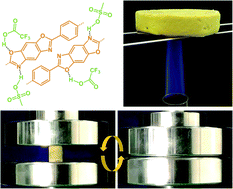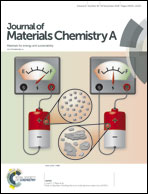Fire-resistant, ultralight, superelastic and thermally insulated polybenzazole aerogels†
Abstract
Efficient and durable thermal insulators combined with flame resistance are required for energy efficient buildings. Here, we fabricate poly(p-phenylene benzobisoxazole) (PBO) nanofiber aerogels (PBOAs) through a proton-consumption-induced gelation of PBO nanofiber sol and a controlled freeze-drying with a low cooling rate, followed by thermal cross-linking. Nanofibrous networks based on physical entanglement of nanofibers and chemical cross-linking at the junctions were obtained, leading to ultralow density (3.6–15.7 mg cm−3), high porosity (98.9–99.7%), high specific surface area (155.4 m2 g−1), low thermal conductivity (26.2–37.7 mW m−1 K−1) and superelasticity under an ultimate strain of 99%. More importantly, the aerogels achieve an excellent thermal stability, including a high decomposition temperature of 650 °C and a high long-term use temperature of 350 °C. Furthermore, the PBOAs are characterized by outstanding flame resistance, reach the nonflammable level in vertical burning tests (UL-94, V-0 class), and show a limiting oxygen index (LOI) as high as 52.8%. The aerogels cannot be ignited under simulated real-scale fire conditions, leaving suppressed smoke emission and reduced potential for flame spread and fire hazards. High thermal insulation and resistance to a 1000 °C flame has been achieved by compositing PBOAs with fumed silica. Thus, the PBOAs have promising applications in energy efficient areas, such as buildings, aerospace and many other fields, especially under harsh conditions.



 Please wait while we load your content...
Please wait while we load your content...